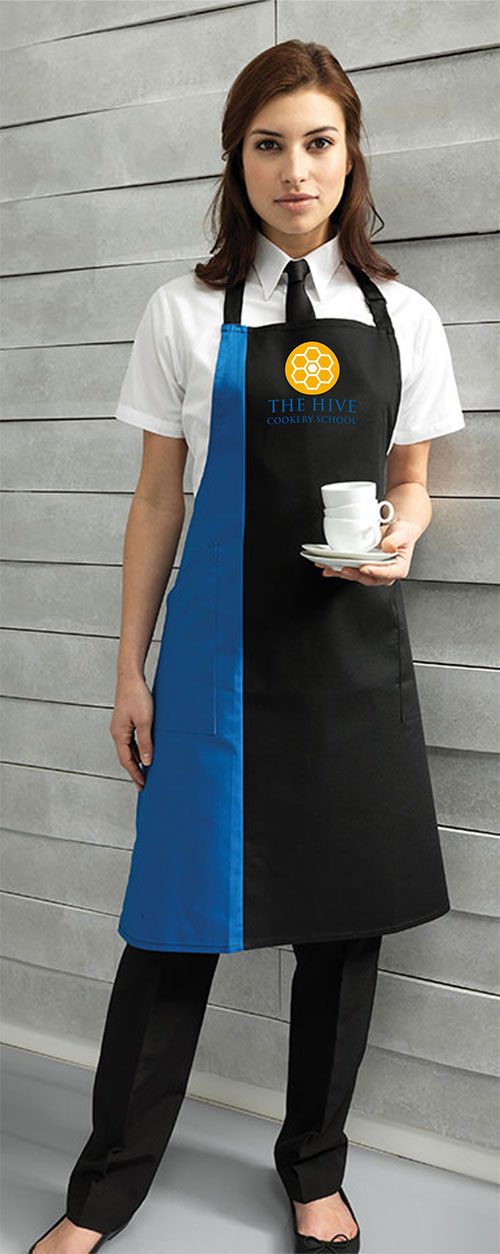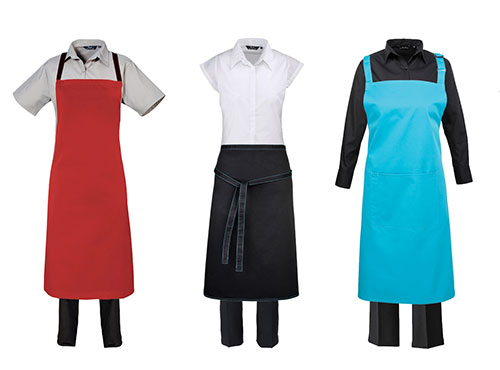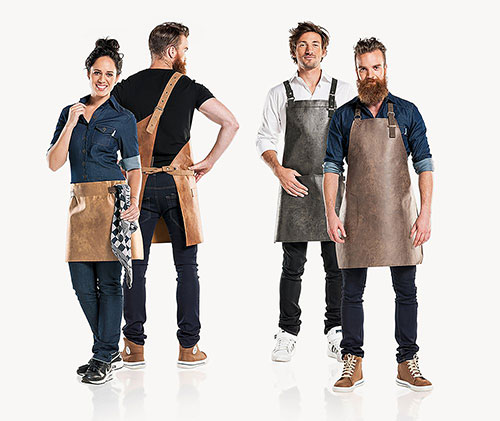How to make an impact with staff uniforms
It isn't just food that has become far more casual; in an increasingly competitive marketplace, the image your staff project through the clothes they wear is more important than ever. Kathy Bowry reports
Anna Wintour, the British editor of American Vogue, once said:"If you can't be better than your competition, just dress better."
And in the case of the sector at the moment, âdressing betterâ almost certainly means dressing more casually.
Banana Moon
As the environments in which we eat out and stay relax, so too must the image of the people who work in them. Out go starchy white shirts, bow ties, and any other accessories that speak of too formal a hospitality experience. And in come styles that even a decade or so ago might have been unthinkable. Rick Shonfeld, director of Dukinfield workwear manufacturer and supplier Tibard, is in no doubt as to just how much fashions have changed: âAt Tibard we deal with uniform on a very large scale and we have seen some interesting demand changes emerge over the past 18 months. A few years ago, we would never have expected our restaurant chain customers to be asking for T-shirts,â he says.
âTraditionally these have been seen as very informal garments, and definitely not for formal or service dining. However, times have changed and T-shirts are fast replacing traditional shirts and blouses. Personalised to the customerâs brand through screen printing, they look good, informal but âsmartâ in the more modern sense of the word. We now supply over 10,000 T-shirts per month to our customers, while 2013 levels were only around 3,000.â
Tibard
Meanwhile, at custom clothing supplier Banana Moon, it isnât just the move to a more relaxed style of dress that they are noticing. Marketing director Alex Grace also points to the way in which new developments are allowing uniform manufacturers to lighten up on colour. âOur customers are moving towards creating their own bespoke branded clothing for their uniforms these days. Colour range is certainly becoming more adventurous,â Grace says.
âOur core clothing range is definitely reflecting that, with many of our uniform brands expanding their colour range vastly to closely match as many branding guidelines as possible. Previously Pantone matches or special colourways would need to be ordered specially in bulk quantities. Now, companies can order their uniforms much more infrequently as the range is readily available for them in just a few days and it reduces their financial outlay.
âWe really enjoy producing those uniforms where the customer will buy a number of contrasting colourways through the chefswear, shirts, polo shirts, aprons and the trousers. With us also offering the personalisation, our customers are becoming really savvy at using the embroidery on the shirt or the print on an apron to bring the uniform to life.ââ
Another key trend is aprons. Where once these may have been seen as an entirely utilitarian garment, the hospitality trade is demanding considerably more style from something that was once purely functional, with materials like leather particularly popular (see Outerwear, below).
In fact, the growth of aprons has been exponential in Schonfeldâs eyes. âWe are seeing an increased interest from customers wanting their own choice of electric colours, all brand-matched to their bright and vibrant businesses â" a far cry from the grey aprons of the past.
âIt is not just the colour that businesses are increasingly starting to dictate, it is the choice of fabric. Again, aprons are the easiest item to produce and short rolls of fabric, while not cheap, are cost effective given the outcome. We have seen denims, linens, tweeds, canvas and leather all regularly requested by customers looking to make their uniforms a talking point.â
Banana Moon
Of course, workwear clothing still has to be practical, however fashionable it may be, and its ability to perform in the environment for which it is intended is still a top requirement. For the kitchen, Nisbets distributes Chef Worksâ culinary uniforms in the UK and Ireland and draws attention to its Chef Works cool vent jacket, recently awarded âApproved Productâ status by the Craft Guild of Chefs (CGC). Andrew Green, director of operations, CGC, says: âJackets are iconic to a chefâs appearance, and are arguably the most essential garment in their working wardrobe. With this in mind, a jacket which exudes the qualities of their profession â" one that offers comfort, style, an exact fit, and aids temperature control â" is vital. The cool vent chefsâ jackets more than satisfy the requirements expected by CGC members, and so it is with great pleasure that Iâm able to announce that they have exceeded the pass mark for our coveted âApproved Productâ status.â
And whatever style you opt for, there are several ways to skin a cat when it comes to sourcing uniforms, as Gillian Farrar, membership services manager and deputy chief executive of the Textile Services Association, explains. âThere are two methods of sourcing uniforms â" you source them yourself and staff either take them home to wash; you wash them in your own on premises laundry or you outsource to a commercial laundry. Alternatively, operators can place the whole enterprise in the hands of a textile rentals company that will manage the whole process for you, including specification, procurement, pick up and delivery and laundering,â she says.
âThese companies, often commercial laundries, will also identify and perform and repairs that need to be done and expertly clean clothing even at low temperatures. Laundries have access to specialist chemicals that will remove soil and ensure real cleanliness in a way that low temperature domestic washing canât. And, there is total traceability, an important factor for foodservice operations.â She adds that professionally laundered uniforms will not only deliver a high standard of cleanliess, they invariably look better than those washed at home because they are properly finished.
Farrar also comments that employers really need to ensure staff have three sets of uniform â" one being worn, one ready to wear and one in the wash. âSome people have more,â she says. âThis lessens the risk of unwashed clothing being put on for the next shift.â
Simon Jersey
Bates of London has been addressing the capitalâs hospitality laundry needs for many years. It says it will return garments in as perfect condition as possible after checking each item for damage and wear and tear every time it is laundered. It will repair and replace garments that have been damaged through fair use and can also draw on a wide range of garments and styles.Â
Fishers, Scotlandâs largest launderer, provides chef and workwear for next day delivery in partnership with Pegasus Textile using Ekocloth, the generic trade name of a series of polyester yarns, fabrics and garments, recycled from used plastic bottles and waste polyester. Fishers explains: âThe quality of Ekocloth is as good and sometimes better than virgin polyester products and because it is recycled, its manufacture consumes less energy.â
Over at designer and manufacturer Simon Jersey, which celebrates its 45th anniversary year by providing Team GB with its kit for the 2016 Olympics in Rio, has some advice on procurement. Design manager Helen Harker says: âAn ideal uniform combines practicality with style and ease of cleaning. We test all of our fabrics to ensure that theyâll stand up to everyday wear in a busy work environment ad are easy to wash and iron. Plus, we think about how people work during the day so that our garments include hidden features that support them. That might include a useful pen pocket or an âaction backâ that gives extra room to bend and stretch.
âAnd this year weâve introduced a new collection of tweed waistcoats and ties to cater for the current heritage fabric trend. These timeless fabrics can be styled formally with a traditional crisp white shirt, or lend themselves equally well to being worn with skinny jeans for a contemporary look.âÂ
Tweed and skinny jeans? With snappy dressing like that, the competition will be quaking in its patent leather shoes.
Circular economy
The Textile Services Association (TSA) is exploring circular economies and ethical sources of linen as a means of improving the industryâs sustainability.
TSAâs Gillian Farrar recommends Uniform Reuse, managed by research and consultancy firm Oakdene Hollins, which helps organisations find a âgreenâ method of disposal.
âUniform Reuse aims to keep corporate wear out of landfill and to improve reuse and recycling options for it,â explains Farrar.Â
âHowever, security of the brand and corporate image can be a big issue as hospitality businesses donât want their branded uniforms being reused inappropriately or ending up somewhere that will give a negative image. The team at Uniform Reuse will ensure that all logos and identifiers are removed before recycling so there is no risk of this happening.â
Outer wear
At first glance these aprons look more suited to a blacksmith, but they are actually from chef clothing provider ChaudDevant via CCS.
âThe Leather70 range of aprons are a combination of 70% cowhide and 30% polyester and are less vulnerable to staining,â says CSS. âThey are great for chefs working in outside kitchens, and the raw edge and single-stitch finish gives the collection a tough appearance.â
The aprons can be easily cleaned with a damp cloth and neutral soap to retain ongevity, says the manufacturer.
Chaud Devant
Suppliers
Banana Moon
Bates of London
CCS
Fishers
Nisbets
Simon Jersey
TSA
Tibard/Oliver Hardy
Uniform Reuse

























